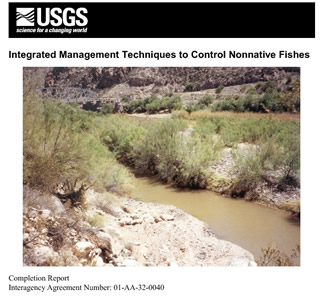Integrated Management Techniques to Control Nonnative Fishes
Download ![]() bor_final_report.pdf 20.9MB
bor_final_report.pdf 20.9MB
 Many species of native fish from the southwestern
United States, including those in the Gila
River basin in Arizona and New Mexico, are critically imperiled in
part because of the
introduction and establishment of nonnative fishes. Effective methods
for eradication and
control of nonnative fishes are needed to rehabilitate the imperiled
native fish fauna of the Gila
River basin. The objective of this report is to assess the potential
of applying techniques of
integrated pest management to protect imperiled native fishes in the
southwestern United States
from invasive nonnative species. To accomplish this, reviews of pertinent
literature were
conducted in selected topic areas and the information presented in
a series of chapters to
document findings.
Many species of native fish from the southwestern
United States, including those in the Gila
River basin in Arizona and New Mexico, are critically imperiled in
part because of the
introduction and establishment of nonnative fishes. Effective methods
for eradication and
control of nonnative fishes are needed to rehabilitate the imperiled
native fish fauna of the Gila
River basin. The objective of this report is to assess the potential
of applying techniques of
integrated pest management to protect imperiled native fishes in the
southwestern United States
from invasive nonnative species. To accomplish this, reviews of pertinent
literature were
conducted in selected topic areas and the information presented in
a series of chapters to
document findings.
Subject areas of the review included (1) life-history strategies for both native and nonnative species in those waters; (2) evaluation, identification, and characteristics of successful integrated pest management programs; (3) identification of potential and existing chemicals and appropriate chemical formulations for use as general and selective piscicides; and (4) procedures and costs associated with the discovery and development of new and perhaps taxon-specific piscicides. Characteristics of native fishes of concern were compared with those of nonnative fishes, and the geographic ranges of native and nonnative fishes were mapped to identify potentially vulnerable conditions around which control strategies could be developed. The concept of chemical receptors and receptor responses are presented to help explain the basis of selective toxicity.
A total of 45 chemicals were identified that have either been used as piscicides, or are currently in various stages of development. A rating system was developed that evaluates the usefulness of these chemicals in resolving problems caused by nonnative fishes. Only five of the chemicals (antimycin, rotenone, TFM, Bayluscide®, and Squoxin) achieved ratings of 75 or greater out of a possible score of 100. Chemical reclamations have not always been successful as indicated by reviews of hundreds of fish control projects with reported successes ranging from 43% to 82%. It is unlikely that the present arsenal of approved selective piscicides would be effective for controlling nonnative fishes in the southwestern United States because the fish communities are different from most areas where selective piscicides are being used, and the currently registered taxon selective piscicides target sea lampreys.
A comprehensive list of formulations and associated delivery systems for applying registered piscicides are presented. The development of new chemical tools for selectively managing fish populations may be facilitated by the knowledge of the mode of action of candidate piscicides and their structure-toxicity relationships. An evaluation of the costs and benefits of chemical treatments, as well as the cost associated with the development and registration of new piscicides, are provided. Reclamation of habitats that are critically imperiled by invasive fishes may need to be implemented using general piscicides such as antimycin or rotenone. This would require that important extant native species be temporarily moved to refugia until after the treatments. In less critical situations, efforts could be directed toward development of integrated pest management techniques that include development and use of barriers, water-level manipulations, targeted overharvest, stocking of predators, sterilants, toxic baits, selective piscicides, attractants and repellants, immuno-contraceptive agents, viruses, chromosomal manipulations, gynogenesis, and transgenics.
- UMESC file types
- Adobe Acrobat Reader (.pdf)
Page Last Modified: April 17, 2018

